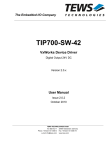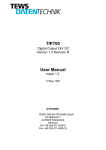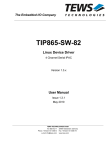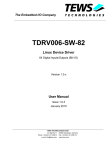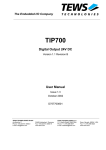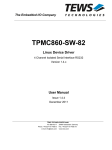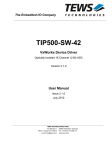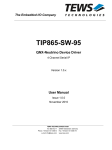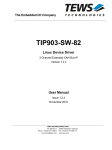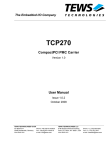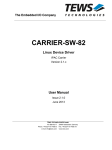Download User Manual - TEWS TECHNOLOGIES
Transcript
The Embedded I/O Company TIP700-SW-82 Linux Device Driver Digital Output 24V DC Version 1.2.x User Manual Issue 1.2.3 June 2014 TEWS TECHNOLOGIES GmbH Am Bahnhof 7 25469 Halstenbek, Germany Phone: +49 (0) 4101 4058 0 Fax: +49 (0) 4101 4058 19 e-mail: [email protected] www.tews.com TIP700-SW-82 This document contains information, which is proprietary to TEWS TECHNOLOGIES GmbH. Any reproduction without written permission is forbidden. Linux Device Driver Digital Output 24V DC TEWS TECHNOLOGIES GmbH has made any effort to ensure that this manual is accurate and complete. However TEWS TECHNOLOGIES GmbH reserves the right to change the product described in this document at any time without notice. Supported Modules: TIP700 TEWS TECHNOLOGIES GmbH is not liable for any damage arising out of the application or use of the device described herein. 2004-2014 by TEWS TECHNOLOGIES GmbH Issue Description Date 1.0 First Issue July 11, 2003 1.1 Support for DEVFS and SMP February 16, 2004 1.2.0 Introduction and installation section modified April 18, 2006 1.2.1 General Revision February 25, 2009 1.2.2 Address TEWS LLC removed October 28, 2010 1.2.3 General Revision June 5, 2014 TIP700-SW-82 – Linux Device Driver Page 2 of 18 Table of Contents 1 INTRODUCTION......................................................................................................... 4 1.1 Device Driver ...................................................................................................................................4 1.2 IPAC Carrier Driver .........................................................................................................................4 2 INSTALLATION.......................................................................................................... 5 2.1 2.2 2.3 2.4 2.5 3 DEVICE INPUT/OUTPUT FUNCTIONS ..................................................................... 8 3.1 3.2 3.3 3.4 4 Build and install the Device Driver................................................................................................6 Uninstall the Device Driver ............................................................................................................6 Install Device Driver into the running Kernel...............................................................................6 Remove Device Driver from the running Kernel..........................................................................7 Change Major Device Number .......................................................................................................7 open..................................................................................................................................................8 close ...............................................................................................................................................10 write................................................................................................................................................11 ioctl .................................................................................................................................................13 3.4.1 T700_IOC_ENABLE_WD.................................................................................................15 3.4.2 T700_IOC_DISABLE_WD................................................................................................16 3.4.3 T700_IOC_TRIGGER_WD...............................................................................................17 DEBUGGING ............................................................................................................ 18 TIP700-SW-82 – Linux Device Driver Page 3 of 18 1 Introduction 1.1 Device Driver The TIP700-SW-82 Linux device driver allows the operation of the TIP700 digital output IPAC conforming to the Linux I/O system specification. This includes a device-independent basic I/O interface with open(), close(), write() and ioctl() functions. The TIP700-SW-82 device driver supports the following features: writing digital output value enable and disable output watchdog The TIP700-SW-82 device driver supports the modules listed below: TIP700-10 16 isolated digital outputs 24V DC IndustryPack ® TIP700-20 8 isolated digital outputs 24V DC IndustryPack ® To get more information about the features and use of TIP700 devices it is recommended to read the manuals listed below. TIP700 User Manual CARRIER-SW-82 IPAC Carrier User Manual 1.2 IPAC Carrier Driver IndustryPack (IPAC) carrier boards have different implementations of the system to IndustryPack bus bridge logic, different implementations of interrupt and error handling and so on. Also the different byte ordering (big-endian versus little-endian) of CPU boards will cause problems on accessing the IndustryPack I/O and memory spaces. To simplify the implementation of IPAC device drivers which work with any supported carrier board, TEWS TECHNOLOGIES has designed a so called Carrier Driver that hides all differences of different carrier boards under a well defined interface. The TEWS TECHNOLOGIES IPAC Carrier Driver CARRIER-SW-82 is part of this TIP700-SW-82 distribution. It is located in directory CARRIER-SW-82 on the corresponding distribution media. This IPAC Device Driver requires a properly installed IPAC Carrier Driver. Due to the design of the Carrier Driver, it is sufficient to install the IPAC Carrier Driver once, even if multiple IPAC Device Drivers are used. Please refer to the CARRIER-SW-82 User Manual for a detailed description how to install and setup the CARRIER-SW-82 device driver, and for a description of the TEWS TECHNOLOGIES IPAC Carrier Driver concept. TIP700-SW-82 – Linux Device Driver Page 4 of 18 2 Installation Following files are located on the distribution media: Directory path ‘TIP700-SW-82’: TIP700-SW-82-SRC.tar.gz TIP700-SW-82-1.2.2.pdf ChangeLog.txt Release.txt GZIP compressed archive with driver source code PDF copy of this manual Release history Release information For installation the files have to be copied to the desired target directory. The GZIP compressed archive TIP700-SW-82-SRC.tar.gz contains the following files and directories: Directory path ‘tip700’: tip700.c tip700def.h tip700.h makenode Makefile example/tip700exa.c example/Makefile include/config.h include/tpmodule.h include/tpmodule.c Driver source code Driver include file Driver include file for application program Script to create device nodes on the file system Device driver make file Example application Example application make file Driver independent library header file Kernel independent library header file Kernel independent library source code file In order to perform an installation, extract all files of the archive TIP700-SW-82-SRC.tar.gz to the desired target directory. The command ‘tar -xzvf TIP700-SW-82-SRC.tar.gz’ will extract the files into the local directory. Before building a new device driver, the TEWS TECHNOLOGIES IPAC carrier driver must be installed properly, because this driver includes the header file ipac_carrier.h, which is part of the IPAC carrier driver distribution. Please refer to the IPAC carrier driver user manual in the directory path CARRIER-SW-82 on the separate distribution media. TIP700-SW-82 – Linux Device Driver Page 5 of 18 2.1 Build and install the Device Driver Login as root Change to the target directory Use the parameter CARRIERDIR to specify the location of the TEWS IPAC Carrier Driver. To create and install the driver in the module directory /lib/modules/<version>/misc assuming the carrier driver being located in /usr/project/ipac_carrier, enter: # make install CARRIERDIR=/usr/project/ipac_carrier If not specifying the CARRIERDIR parameter, there may be compiler warnings claiming some undefined ipac_* symbols. These warnings are caused by the IPAC Carrier Driver, which is unknown during compilation of this TIP driver. Also after the first build we have to execute depmod to create a new dependency description for loadable kernel modules. This dependency file is later used by modprobe to automatically load the correct IPAC carrier driver modules. # depmod –a 2.2 Uninstall the Device Driver Login as root Change to the target directory To remove the driver from the module directory /lib/modules/<version>/misc enter: # make uninstall Update kernel module dependency description file: # depmod –aq 2.3 Install Device Driver into the running Kernel To load the device driver into the running kernel, login as root and execute the following commands: # modprobe tip700drv After the first build or if you are using dynamic major device allocation it’s necessary to create new device nodes on the file system. Please execute the script file makenode to do this. If your kernel has enabled a dynamic device file system (devfs or sysfs with udev) then you have to skip running the makenode script. Instead of creating device nodes from the script the driver itself takes creating and destroying of device nodes in its responsibility. # sh makenode TIP700-SW-82 – Linux Device Driver Page 6 of 18 On success the device driver will create a minor device for each TIP700 module found. The first TIP700 can be accessed with device node /dev/tip700_0, the second TIP700 with device node /dev/tip700_1, the third TIP700 with device node /dev/tip700_2 and so on. The allocation of device nodes to physical TIP700 modules depends on the search order of the IPAC carrier driver. Please refer to the IPAC carrier user manual. Loading of the TIP700 device driver will only work if kernel KMOD support is installed, necessary carrier board drivers already installed and the kernel dependency file is up to date. If KMOD support isn’t available you have to build either a new kernel with KMOD installed or you have to install the IPAC carrier kernel modules manually in the correct order (please refer to the IPAC carrier driver user manual). 2.4 Remove Device Driver from the running Kernel To remove the device driver from the running kernel login as root and execute the following command: # modprobe tip700drv –r If your kernel has enabled a dynamic device file system (devfs or sysfs with udev) all /dev/tip700_x nodes will be automatically removed from your file system after this. Be sure that the driver isn’t opened by any application program. If opened you will get the response “tip700drv: Device or resource busy” and the driver will still remain in the system until you close all opened files and execute modprobe –r again. 2.5 Change Major Device Number The TIP700 driver uses dynamic allocation of major device numbers by default. If this isn’t suitable for the application it’s possible to define a major number for the driver. If the kernel has enabled a dynamic files system the driver will not use the symbol TIP700_MAJOR. To change the major number edit the file tip700.c, change the following symbol to appropriate value and enter make install to create a new driver. TIP700_MAJOR Valid numbers are in range between 0 and 255. A value of 0 means dynamic number allocation. Example: #define TIP700_MAJOR TIP700-SW-82 – Linux Device Driver 122 Page 7 of 18 3 Device Input/Output functions This chapter describes the interface to the device driver I/O system. 3.1 open NAME open() - open a file descriptor SYNOPSIS #include <fcntl.h> int open (const char *filename, int flags) DESCRIPTION The open function creates and returns a new file descriptor for the file named by filename. The flags argument controls how the file is to be opened. This is a bit mask; you create the value by the bitwise OR of the appropriate parameters (using the | operator in C). See also the GNU C Library documentation for more information about the open function and open flags. EXAMPLE int fd; fd = open(“/dev/tip700_0”, O_RDWR); if (fd < 0) { /* handle error condition */ } RETURNS The normal return value from open is a non-negative integer file descriptor. In the case of an error, a value of –1 is returned. The global variable errno contains the detailed error code. TIP700-SW-82 – Linux Device Driver Page 8 of 18 ERRORS Error Code Description ENODEV The requested minor device does not exist. This is the only error code returned by the driver, other codes may be returned by the I/O system during open. SEE ALSO GNU C Library description – Low-Level Input/Output TIP700-SW-82 – Linux Device Driver Page 9 of 18 3.2 close NAME close() – close a file descriptor SYNOPSIS #include <unistd.h> int close (int filedes) DESCRIPTION The close function closes the file descriptor filedes. EXAMPLE int fd; if (close(fd) != 0) { /* handle close error conditions */ } RETURNS The normal return value from close is 0. In the case of an error, a value of –1 is returned. The global variable errno contains the detailed error code. ERRORS Error Code Description ENODEV The requested minor device does not exist. This is the only error code returned by the driver, other codes may be returned by the I/O system during close. For more information about close error codes, see the GNU C Library description – LowLevel Input/Output. SEE ALSO GNU C Library description – Low-Level Input/Output TIP700-SW-82 – Linux Device Driver Page 10 of 18 3.3 write NAME write() – write to a device SYNOPSIS #include <unistd.h> ssize_t write(int filedes, void *buffer, size_t size) DESCRIPTION This function writes to the output registers of the TIP700 associated with the file descriptor filedes from a structure (T700_BUFFER) pointed to by buffer. The argument size specifies the length of the buffer and must be set to the size of the structure T700_BUFFER. typedef struct { unsigned short } T700_BUFFER; value; value 0 This parameter holds the new value for output lines 1 to 16. Where bit 2 corresponds to output 1 line 1, bit 2 to output line 2, and so on. EXAMPLE #include <tip700.h> int ssize_t T700_BUFFER fd; num_bytes; io_buf; io_buf.value = 0x1234; num_bytes = write(fd, &io_buf, sizeof(T700_BUFFER)); if (num_bytes != sizeof(T700_BUFFER)) { // process error; } TIP700-SW-82 – Linux Device Driver Page 11 of 18 RETURNS On success write returns the size of bytes written (always the size of T700_BUFFER). In the case of an error, a value of –1 is returned. The global variable errno contains the detailed error code. ERRORS Error Code Description EINVAL This error code is returned if the size of the buffer is wrong. SEE ALSO GNU C Library description – Low-Level Input/Output TIP700-SW-82 – Linux Device Driver Page 12 of 18 3.4 ioctl NAME ioctl() – device control functions SYNOPSIS #include <sys/ioctl.h> int ioctl(int filedes, int request [, void *argp]) DESCRIPTION The ioctl function sends a control code directly to a device, specified by filedes, causing the corresponding device to perform the requested operation. The argument request specifies the control code for the operation. The optional argument argp depends on the selected request and is described for each request in detail later in this chapter. The following ioctl codes are defined in tip700.h: Symbol Meaning T700_IOC_ENABLE_WD Enable output watchdog T700_IOC_DISABLE_WD Disable output watchdog T700_IOC_TRIGGER_WD Trigger output watchdog See behind for more detailed information on each control code. To use these TIP700 specific control codes the header file tip700.h must be included in to the application RETURNS On success, zero is returned. In the case of an error, a value of –1 is returned. The global variable errno contains the detailed error code. TIP700-SW-82 – Linux Device Driver Page 13 of 18 ERRORS Error Code Description EINVAL Invalid argument. This error code is returned if the requested ioctl function is unknown. Please check the argument request. Other function dependant error codes will be described for each ioctl code separately. Note, the TIP700 driver always returns standard Linux error codes. SEE ALSO ioctl man pages TIP700-SW-82 – Linux Device Driver Page 14 of 18 3.4.1 T700_IOC_ENABLE_WD NAME T700_IOC_ENABLE_WD - Enable output watchdog DESCRIPTION This ioctl function enables the output watchdog facility of the TIP700. If the output watchdog is not retriggered within approximately 120 milliseconds the state of the output register will be set to inactive. The watchdog is triggered implicitly by a write to the output register or by executing the ioctl function T700_IOC_TRIGGER_WD. The initialization state (driver startup) of the output watchdog is disabled. EXAMPLE #include <tip700.h> int int fd; result; result = ioctl(fd, T700_IOC_ENABLE_WD); if (result < 0) { /* handle ioctl error */ } TIP700-SW-82 – Linux Device Driver Page 15 of 18 3.4.2 T700_IOC_DISABLE_WD NAME T700_IOC_DISABLE_WD - Disable output watchdog DESCRIPTION This ioctl function disables the output watchdog facility of the TIP700. The initialization state (driver startup) of the output watchdog is disabled. EXAMPLE #include <tip700.h> int int fd; result; result = ioctl(fd, T700_IOC_DISABLE_WD); if (result < 0) { /* handle ioctl error */ } TIP700-SW-82 – Linux Device Driver Page 16 of 18 3.4.3 T700_IOC_TRIGGER_WD NAME T700_IOC_TRIGGER_WD - Trigger output watchdog DESCRIPTION This ioctl function triggers the output watchdog of the TIP700. If the output watchdog is not retriggered within approximately 120 milliseconds the state of the output register will be set to inactive. The watchdog is triggered implicitly by a write to the output register or by executing this ioctl function. The initialization state (driver startup) of the output watchdog is disabled. EXAMPLE #include <tip700.h> int int fd; result; result = ioctl(fd, T700_IOC_TRIGGER_WD); if (result < 0) { /* handle ioctl error */ } TIP700-SW-82 – Linux Device Driver Page 17 of 18 4 Debugging For debugging output see tip700.c. You will find the following symbol: #undef TIP700_DEBUG_VIEW To enable a debug output replace “undef” with “define”. The TIP700_DEBUG_VIEW symbol controls debugging output from the whole driver. TIP700 – 8 or 16 Digital Outputs version 1.2.x (Release Date)<6> TIP700 : Probe new TIP700 mounted on <TEWS TECHNOLOGIES - (Compact)PCI IPAC Carrier> at slot A TIP700 : IP I/O Memory Space 00000000 : 00 01 FF 01 TIP700 : 00000000 : 00000010 : 00000020 : 00000030 : TIP700 TIP700 IP FF FF FF FF ID 49 00 00 00 Memory Space FF 50 FF 41 FF FF 00 FF 0C FF FF 00 FF 00 FF FF 00 FF 00 FF 43 D7 00 00 FF FF FF FF B3 00 00 00 FF FF FF FF 05 00 00 00 FF FF FF FF 10 00 00 00 FF FF FF FF 00 00 00 00 : IOCTL : T700_IOC_ENABLE_WD : IOCTL : T700_IOC_DISABLE_WD TIP700-SW-82 – Linux Device Driver Page 18 of 18


















